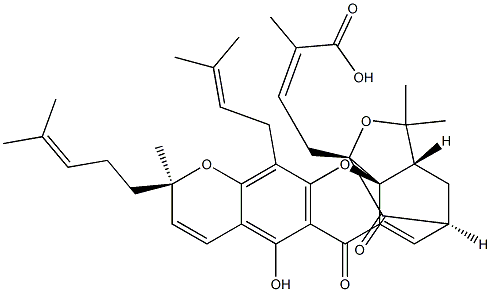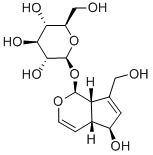SANTALOL
- CAS NO.:11031-45-1
- Empirical Formula: C15H24O
- Molecular Weight: 220.35
- MDL number: MFCD00046301
- EINECS: 234-262-4
- SAFETY DATA SHEET (SDS)
- Update Date: 2024-12-18 14:08:57

What is SANTALOL?
Chemical properties
Santalol (α- and β-) has a sweet, sandalwood odor.
Occurrence
The stereochemistry of santalols has been discussed by Brieger (Burdock, 1995); santalols are found among the constituents of various sandalwood species (Santalum album L., S. spicatum, S. autrocaledonicum); the α- and β-isomers are present in varying ratios, with the α-isomer usually more abundant.
The Uses of SANTALOL
Santalol is a naturally occuring sesquiterpene that has antibacterial, anti-hyperglycaemic, anti inflammatory and antioxidant effects with a sweet woody odor making it useful in essential oils.
The Uses of SANTALOL
Santalol, α- and β-isomers are used as analytical standards for the quantification of the analytes in fragrances using flow-modulation comprehensive two-dimensional gas chromatography coupled to mass spectrometry (FM GCxGC/MS).
The Uses of SANTALOL
Santalol is a flavoring agent that is a colorless or pale yellow liquid, with odor resembling sandalwood. it is soluble in alcohol, fixed oils, mineral oil, and propylene glycol; and insoluble in water and glyc- erin. it is obtained from a sandalwood oil source.
Synthesis
The commercial product is generally a mixture of α- and β-santalol obtained by fractional distillation of sandalwood oil; noncommercial syntheses are known.
Properties of SANTALOL
| Density | 0.968 g/mL at 25 °C(lit.) |
| refractive index | n20/D 1.507(lit.) |
| FEMA | 3006 | SANTALOL (ALPHA AND BETA ) |
| storage temp. | -20°C |
| solubility | Chloroform (Slightly), Methanol (Slightly) |
| form | Oil |
| color | Colourless |
| Odor | at 100.00 %. deep sweet sandalwood woody |
| JECFA Number | 984 |
| Boiling point: | 101-103°C/0.1 mmHg(lit.) |
| EPA Substance Registry System | Santalol (11031-45-1) |
Safety information for SANTALOL
| Signal word | Warning |
| Pictogram(s) |
 Exclamation Mark Irritant GHS07 |
| GHS Hazard Statements |
H315:Skin corrosion/irritation H319:Serious eye damage/eye irritation H335:Specific target organ toxicity, single exposure;Respiratory tract irritation |
| Precautionary Statement Codes |
P261:Avoid breathing dust/fume/gas/mist/vapours/spray. P305+P351+P338:IF IN EYES: Rinse cautiously with water for several minutes. Remove contact lenses, if present and easy to do. Continuerinsing. |
Computed Descriptors for SANTALOL
New Products
(S)-3-Aminobutanenitrile hydrochloride 4-Methylphenylacetic acid N-Boc-D-alaninol N-BOC-D/L-ALANINOL Tert-butyl bis(2-chloroethyl)carbamate 3-Morpholino-1-(4-nitrophenyl)-5,6-dihydropyridin- 2(1H)-one Furan-2,5-Dicarboxylic Acid Tropic acid 1-Bromo-3,5-Di-Tert-Butylbenzene S-2-CHLORO PROPIONIC ACID ETHYL ISOCYANOACETATE 2-Bromo-1,3-Bis(Dimethylamino)Trimethinium Hexafluorophosphate 4-IODO BENZOIC ACID 3-NITRO-2-METHYL ANILINE 1-(2,4-DICHLOROPHENYL) ETHANAMINE (2-Hydroxyphenyl)acetonitrile 4-Bromopyrazole 2-(Cyanocyclohexyl)acetic acid 4-methoxy-3,5-dinitropyridine 1-(4-(aminomethyl)benzyl)urea hydrochloride 2-aminopropyl benzoate hydrochloride diethyl 2-(2-((tertbutoxycarbonyl)amino) ethyl)malonate tert-butyl 4- (ureidomethyl)benzylcarbamate Ethyl-2-chloro((4-methoxyphenyl)hydrazono)acetateRelated products of tetrahydrofuran

![(3beta,5alpha,11alpha,12beta,14beta,17alpha)-12-(Acetyloxy)-3-[[2,6-dideoxy-4-O-(6-deoxy-3-O-methyl-beta-D-allopyranosyl)-3-O-methyl-beta-D-arabinohexopyranosyl]oxy]-8,14-epoxy-11-(2-methyl-1-oxobutoxy)pregnan-20-one](https://img.chemicalbook.in/CAS/20180906/GIF/191729-45-0.gif)






You may like
-
 Santalol CAS 11031-45-1View Details
Santalol CAS 11031-45-1View Details
11031-45-1 -
 Santalol, α- and β-isomers CAS 11031-45-1View Details
Santalol, α- and β-isomers CAS 11031-45-1View Details
11031-45-1 -
 1975-50-4 98%View Details
1975-50-4 98%View Details
1975-50-4 -
 2-HYDROXY BENZYL ALCOHOL 98%View Details
2-HYDROXY BENZYL ALCOHOL 98%View Details
90-01-7 -
 2-Chloro-1,3-Bis(Dimethylamino)Trimethinium Hexafluorophosphate 221615-75-4 98%View Details
2-Chloro-1,3-Bis(Dimethylamino)Trimethinium Hexafluorophosphate 221615-75-4 98%View Details
221615-75-4 -
 61397-56-6 CIS BROMO BENZOATE 98%View Details
61397-56-6 CIS BROMO BENZOATE 98%View Details
61397-56-6 -
 14714-50-2 (2-Hydroxyphenyl)acetonitrile 98+View Details
14714-50-2 (2-Hydroxyphenyl)acetonitrile 98+View Details
14714-50-2 -
 118753-70-1 98+View Details
118753-70-1 98+View Details
118753-70-1